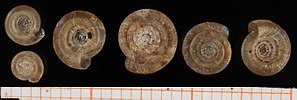Keeled bowl snail
| Keeled bowl snail | ||||||||||||
|---|---|---|---|---|---|---|---|---|---|---|---|---|

Keeled bowl snail ( Discus perspectivus ) |
||||||||||||
| Systematics | ||||||||||||
|
||||||||||||
| Scientific name | ||||||||||||
| Discus perspectivus | ||||||||||||
| ( Megerle von Mühlfeld , 1816) |
The keeled bowl snail ( Discus perspectivus ), also keeled key snail, is a species of snail in the family of bowl snails (Patulidae) from the suborder of land snails (Stylommatophora).
features
The case is very flat-cone-shaped and is also absolutely very flat. In the adult stage, it measures 5.5 to 6.5 mm in diameter and 1.6 to 1.9 mm in height. The 5.5 to 6 whorls (up to 6.5 whorls) slowly increase and have a sharp edge on the periphery. There is a shallow hollow under the keel. The mouth is rhombic with a sharp but very fragile, but not bent, mouth rim. The navel is very wide and reaches about 40 to almost 50% of the width of the case.
The housing is uniformly pale yellowish, yellowish brown or greenish brown in color; the surface does not shine. It has numerous, regularly arranged fine ribs.
The genital apparatus is structured comparatively simply. The short sperm duct ends apically into the moderately long penis. The penile retractor muscle attaches to the penis laterally and clearly away from the confluence of the spermatic duct. The free fallopian tube and vagina are moderate and about the same length. The spermathec is elongated and sits on a long stem. The protein gland (albumin gland) is finger-shaped and long.
Similar species
The keeled bowl snail differs from the spotted bowl snail ( Discus rotundatus ) and the brown bowl snail ( Discus ruderatus ) by the keel, the very flat shell and the much wider navel .
Geographical distribution and habitat
The main distribution areas of the species are the Eastern Alps, the Carpathians and the Balkans. In Germany there are only a few occurrences north of the Alps, in Swabia, north to the Franconian Jura and the Bavarian Forest.
The animals live in the litter of dry forests on calcareous subsoil in the mountains and hills, at the foot of rocks, in the moss and under the bark of old, rotten tree trunks. It rises to about 2000 m above sea level.
Way of life
The animals are hermaphrodites, which usually fertilize each other. Self-fertilization is unlikely to be possible. Between May and August each individual lays around 17 to 33 large eggs (with a diameter of 1 mm) in small clutches of 1 to 9 eggs (usually 3 to 4). After 24 to 35 days, the young hatch from the eggs of a clutch almost simultaneously, and they already have a housing with 1.8 to 2.3 coils. After hatching, the young animals eat the egg shell. Initially, they grow at a rate of about one turn in four months. However, the time it takes to form a curl varies greatly from person to person (49 to 188 days). Under natural conditions, the animals form 2.6 to 3.5 coils before they go into hibernation. Sexual maturity is reached in the following year when the case has a little more than 5 turns. The animals live to be two to three years old.
Taxonomy
The taxon was first described by Johann Carl Megerle von Mühlfeld as Helix perspectivus . It is now generally accepted as part of the genus Discus Fitzinger, 1833.
Danger
The species is considered endangered in Germany. However, the species is not endangered across the entire range. However, stocks seem to be decreasing.
literature
- Michael P. Kerney, RAD Cameron & Jürgen H. Jungbluth: The land snails of Northern and Central Europe. 384 pp., Paul Parey, Hamburg & Berlin 1983, ISBN 3-490-17918-8 , pp. 137/38.
Individual evidence
- ↑ Jürgen H. Jungbluth and Dietrich von Knorre: Trivial names of land and freshwater mollusks in Germany (Gastropoda et Bivalvia). Mollusca, 26 (1): 105-156, Dresden 2008 ISSN 1864-5127 , p. 121.
- ↑ Klaus Bogon: Landschnecken biology, ecology, biotope protection. 404 p., Natur Verlag, Augsburg 1990 ISBN 3-89440-002-1 , p. 159/60.
- ↑ a b c Francisco W. Welter-Schultes: European non-marine molluscs, a guide for species identification = identification book for European land and freshwater mollusks. A1-A3 S., 679 S., Q1-Q78 S., Göttingen, Planet Poster Ed., 2012 ISBN 3-933922-75-5 , ISBN 978-3-933922-75-5 (S. 214)
- ↑ AnimalBase: Discus perspectivus (Megerle von Mühlfeld, 1816)
- ^ Alexandru V. Grossu: Gastropoda Romaniae 4 Ordo Stylommatophora Suprafam: Arionacea, Zonitacea, Ariophantacea şi Helicacea. 564 S., Bucharest 1983, pp. 31-33.
- ↑ Elżbieta Kuźnik-Kowalska: Life cycle and population dynamics of Discus perspectivus (Megerle von Muhlfeld, 1818) (Gastropoda: pulmonata: Endodontidae). Folia Malacologica, 13 (4): 157-168, 2005. PDF
- ^ Johann Carl Megerle von Mühlfeld: Description of some new [sic] Conchylien. Gesellschaft Naturforschender Freunde zu Berlin Magazine for the latest discoveries in natural history as a whole, 8 (1): 3-11, Berlin 1816 Online at Göttinger Digitization Center , p. 11, plate 2, Fig. 19a, b.
- ↑ a b Vollrath Wiese: The land snails of Germany. 352 pp., Quelle & Meyer, Wiebelsheim 2014 ISBN 978-3-494-01551-4 (p. 163)
- ↑ The IUCN Red List of Threatened Species: Discus perspectivus
